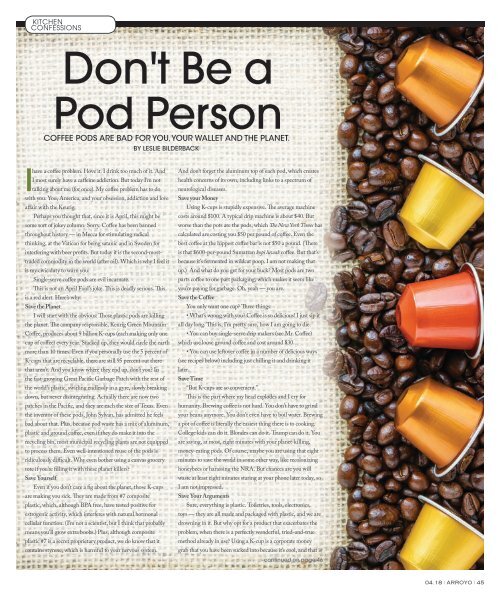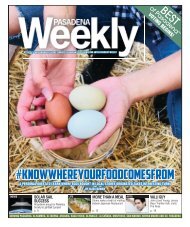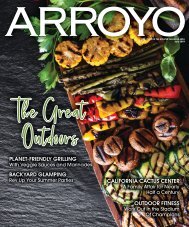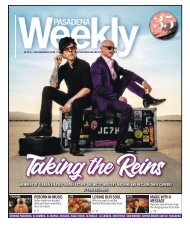April 2018
Create successful ePaper yourself
Turn your PDF publications into a flip-book with our unique Google optimized e-Paper software.
KITCHEN<br />
CONFESSIONS<br />
Don't Be a<br />
Pod Person<br />
COFFEE PODS ARE BAD FOR YOU, YOUR WALLET AND THE PLANET.<br />
BY LESLIE BILDERBACK<br />
Ihave a coffee problem. I love it. I drink too much of it. And<br />
I most surely have a caffeine addiction. But today I’m not<br />
talking about me (for once). My coffee problem has to do<br />
with you. You, America, and your obsession, addiction and love<br />
affair with the Keurig.<br />
Perhaps you thought that, since it is <strong>April</strong>, this might be<br />
some sort of jokey column. Sorry. Coffee has been banned<br />
throughout history — in Mecca for stimulating radical<br />
thinking, at the Vatican for being satanic and in Sweden for<br />
interfering with beer profits. But today it is the second-mosttraded<br />
commodity in the world (after oil). Which is why I feel it<br />
is my civic duty to warn you:<br />
Single-serve coffee pods are evil incarnate.<br />
This is not an <strong>April</strong> Fool’s joke. This is deadly serious. This<br />
is a red alert. Here’s why:<br />
Save the Planet<br />
I will start with the obvious: Those plastic pods are killing<br />
the planet. The company responsible, Keurig Green Mountain<br />
Coffee, produces about 9 billion K-cups (each making only one<br />
cup of coffee) every year. Stacked up, they would circle the earth<br />
more than 10 times. Even if you personally use the 5 percent of<br />
K-cups that are recyclable, there are still 95 percent out there<br />
that aren’t. And you know where they end up, don’t you? In<br />
the fast-growing Great Pacific Garbage Patch with the rest of<br />
the world’s plastic, swirling endlessly in a gyre, slowly breaking<br />
down, but never disintegrating. Actually there are now two<br />
patches in the Pacific, and they are each the size of Texas. Even<br />
the inventor of these pods, John Sylvan, has admitted he feels<br />
bad about that. Plus, because pod waste has a mix of aluminum,<br />
plastic and ground coffee, even if they do make it into the<br />
recycling bin, most municipal recycling plants are not equipped<br />
to process them. Even well-intentioned reuse of the pods is<br />
ridiculously difficult. Why even bother using a canvas grocery<br />
tote if you’re filling it with these planet killers?<br />
Save Yourself<br />
Even if you don’t care a fig about the planet, those K-cups<br />
are making you sick. They are made from #7 composite<br />
plastic, which, although BPA free, have tested positive for<br />
estrogenic activity, which interferes with natural hormonal<br />
cellular function. (I’m not a scientist, but I think that probably<br />
means you’ll grow extra boobs.) Plus, although composite<br />
plastic #7 is a secret proprietary product, we do know that it<br />
contains styrene, which is harmful to your nervous system.<br />
And don’t forget the aluminum top of each pod, which creates<br />
health concerns of its own, including links to a spectrum of<br />
neurological diseases.<br />
Save your Money<br />
Using K-cups is stupidly expensive. The average machine<br />
costs around $100. A typical drip machine is about $40. But<br />
worse than the pots are the pods, which The New York Times has<br />
calculated are costing you $50 per pound of coffee. Even the<br />
best coffee at the hippest coffee bar is not $50 a pound. (There<br />
is that $600-per-pound Sumatran kopi luwak coffee. But that’s<br />
because it’s fermented in wildcat poop. I am not making that<br />
up.) And what do you get for your buck? Most pods are two<br />
parts coffee to one part packaging, which makes it seem like<br />
you’re paying for garbage. Oh, yeah — you are.<br />
Save the Coffee<br />
You only want one cup? Three things:<br />
• What’s wrong with you? Coffee is so delicious! I just sip it<br />
all day long. This is, I’m pretty sure, how I am going to die.<br />
• You can buy single-serve drip makers (see Mr. Coffee)<br />
which use loose ground coffee and cost around $30.<br />
• You can use leftover coffee in a number of delicious ways<br />
(see recipes below) including just chilling it and drinking it<br />
later.<br />
Save Time<br />
“But K-cups are so convenient.”<br />
This is the part where my head explodes and I cry for<br />
humanity. Brewing coffee is not hard. You don’t have to grind<br />
your beans anymore. You don't even have to boil water. Brewing<br />
a pot of coffee is literally the easiest thing there is to cooking.<br />
College kids can do it. Blondes can do it. Trump can do it. You<br />
are saving, at most, eight minutes with your planet-killing,<br />
money-eating pods. Of course, maybe you are using that eight<br />
minutes to save the world in some other way, like recolonizing<br />
honeybees or harassing the NRA. But chances are you will<br />
waste at least eight minutes staring at your phone later today, so<br />
I am not impressed.<br />
Save Your Arguments<br />
Sure, everything is plastic. Toiletries, tools, electronics,<br />
toys — they are all made and packaged with plastic, and we are<br />
drowning in it. But why opt for a product that exacerbates the<br />
problem, when there is a perfectly wonderful, tried-and-true<br />
method already in use? Using a K-cup is a corporate money<br />
grab that you have been sucked into because it’s cool, and that is<br />
–continued on page 46<br />
04.18 | ARROYO | 45

















